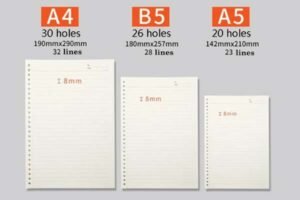
Ever bought a 5-subject notebook, only to find some sections fill up way too fast while others stay empty? It's a common frustration that can mess with your organization. But what if you knew the typical page count1 and how to get exactly what you need?
A standard 5-subject notebook usually contains between 150 and 250 total pages. This means each of the five sections will typically have about 30 to 50 pages. However, this can vary widely among manufacturers and specific notebook designs.
The "standard" range of 30 to 50 pages per subject, totaling 150 to 250 pages, is a general guideline we often see in the market. As manufacturers, we at NotebookRing® understand that this count is often determined by balancing factors like typical academic semester lengths, average note-taking needs, and the overall portability of the notebook. Too few pages per subject, and users run out quickly. Too many, and the notebook becomes heavy and cumbersome. The goal is to hit a sweet spot that serves most users well for a defined period, like a school term or a specific project cycle.
This common page count aims to provide enough space for distinct subjects without making the notebook overly thick. For instance, a student might use one section for math, another for history, and so on. Professionals might divide projects or meeting types across the sections. The physical constraints of binding also play a role; a very high page count can strain certain binding types or make the notebook difficult to use comfortably.
What Factors Influence the Page Count in a 5-Subject Notebook?
So, you've seen the typical range, but what actually makes one notebook have 150 pages and another 250? It's not random; several key elements drive this decision from a manufacturing perspective.
The primary factors influencing page count are the intended use (academic, professional, project-based), the weight and thickness of the paper used, and the type of binding, which can limit the notebook's overall bulk and page capacity.

Let's dive deeper into these elements:
Intended Use and Target Audience
The purpose of the notebook heavily dictates its design, including page count.
- Students: Often need more pages per subject, especially for note-heavy courses. A notebook designed for a full semester might lean towards the higher end of the page count, like our bulk customized school badge notebooks (often 50 pages/book).
- Professionals: Might use sections for different projects or meeting types. Their note-taking might be less voluminous per section but spread across more varied topics. Corporate gift sets, like our hot-stamped LOGO business sets, might prioritize a sleek profile over maximum page count.
- Creative Projects: For something like our plant atlas notebook series developed for a German chain bookstore, the focus might be on specific paper qualities and lay-flat binding, with page count determined by the content (e.g., one page per plant species).
Paper Weight and Thickness
Paper isn't just paper; its properties significantly impact the final notebook.
- Grams per Square Meter (GSM): This is a measure of paper density.
- Lighter Paper (e.g., 70-80gsm): Thinner, allows for more pages within the same notebook thickness. Good for general note-taking. We often use 80gsm as a standard, but can go lower.
- Heavier Paper (e.g., 100-120gsm): Thicker, more robust, better for preventing ink bleed-through, especially with fountain pens or markers. However, this means fewer pages to maintain a manageable notebook size. Our option to upgrade from 80gsm to 100gsm adds about $0.07/book, reflecting the material difference.
- Specialty Papers: Japanese Tomoe River paper, for example, is famously thin yet fountain pen friendly, allowing a higher page count without excessive bulk.
Here's a simple comparison:
| Paper Weight | Common Use | Page Count Impact | Our Typical Offering |
|---|---|---|---|
| 70-80gsm | General Notes | More pages | Standard |
| 90-100gsm | Smoother Writing | Moderate pages | Upgrade Option |
| 120gsm+ | Sketching, Heavy Ink | Fewer pages | European Sketch Paper |
Binding Method
How the pages are held together also influences how many can be comfortably included.
- Spiral/Coil Binding: Very flexible, allows notebooks to lay flat or fold back. Can accommodate a good number of pages. Our patented "seamless coil" technology ensures a smooth 360° touch.
- Sewn Glue Binding: Pages are sewn in sections (signatures) then glued to the spine. This is durable but can be stiffer. Achieving a lay-flat design (like our 180° flat plant atlas) requires specific techniques, like bare spine binding.
- Metal Binder Systems (Ring Binders): Offers refillability. The "page count" is defined by the ring capacity (e.g., our 6-hole/20-hole/26-hole compatible systems). The rings themselves have diameter limits.
- Stapled/Saddle-Stitched: Typically for thinner notebooks or booklets, not common for 5-subject notebooks with many pages.
Manufacturer Design Choices and Market Niche
Sometimes, a brand establishes a certain style or caters to a specific niche.
- Boutique Brands: Like some of our Japanese and Korean boutique channel clients, might prioritize unique aesthetics or ultra-portability (e.g., the ultra-thin weekly planner requiring ≤8mm thickness, which challenges traditional glue binding for 200+ pages).
- Eco-conscious Brands: Might use slightly thicker recycled paper, which could mean a marginally lower page count for the same spine width unless specific thin recycled papers are sourced. We offer recycled paper options with no surcharge.
How Do I Choose the Right Number of Pages for My 5-Subject Notebook?
Knowing the typical counts and influencing factors is great, but how do you pick the notebook with the page count that’s perfect for you? It’s about matching the notebook to your specific needs.
To choose the right page count, first assess your note-taking habits for each subject. Then, consider how long you need the notebook to last (e.g., one semester, a full year) and balance this with your preference for portability versus comprehensiveness.
Let's break this down:
Analyze Your Note-Taking Style
- Heavy Note-Taker: If you write extensively, use diagrams, or have subjects requiring lots of detailed notes (like law or medicine), aim for sections with 40-50+ pages.
- Concise Note-Taker: If your notes are more about key points, summaries, or outlines, 30 pages per section might be perfectly adequate.
- Digital Augmentation: If you supplement paper notes with digital resources, you might need fewer physical pages.
Consider the Duration and Intensity
- Single Semester vs. Full Year: A notebook for one semester of five classes will need fewer pages per subject than one intended to last an entire academic year covering the same subjects.
- Project-Based Work: If you're using it for projects, estimate the scope. Short-term projects need fewer pages than long-term, ongoing ones.
Portability vs. Capacity
- Carrying it Everywhere? A lighter notebook with fewer pages (e.g., 150 total) is easier to carry daily.
- Desk-Based? If it mostly stays on your desk, a larger capacity (e.g., 250 pages) might be fine, offering the convenience of having everything in one place for longer.
Subject-Specific Needs
Not all subjects are equal in terms of an_d page consumption.
- Example: Math or engineering might fill pages with formulas and diagrams quickly. Literature or history might involve more dense text notes.
- Solution: If your subjects have very different needs, a standard equal-division 5-subject notebook might not be ideal. This is where customization becomes powerful. Some users might even prefer a 3-subject notebook for heavy topics and a separate 2-subject for lighter ones.
Can I Customize the Number of Pages in a 5-Subject Notebook?
What if the standard off-the-shelf options just don't cut it? Maybe you need way more pages for one subject and fewer for others. This is a common scenario we encounter.
Yes, you absolutely can customize the number of pages! As a dedicated manufacturer, NotebookRing® specializes in creating bespoke notebooks. This includes adjusting total page counts, the number of pages per section, and even adding custom-printed dividers to perfectly match your unique requirements.

Working directly with a manufacturer like us opens up a world of possibilities beyond standard retail offerings:
Why Opt for Custom Page Counts?
- Uneven Subject Needs: Just like Sarah Müller, a purchasing director for German chain bookstores, needed campus notebooks where inner pages contained subject classification indexes – implying specific sectioning. Or perhaps one subject is extremely note-heavy while others are minimal.
- Specific Project Durations: You might need a notebook to last for a precise project timeline, requiring a specific number of pages.
- Unique Formats: For instance, the Japanese stationery brand we partnered with needed pre-cut dotted line tearing functions, which also involves decisions about how many such pages fit best.
The NotebookRing® Customization Process
We've built our production around flexibility.
- Consultation: We discuss your needs – are you like James Wong from Singapore, needing a specific number of weekly plan inner pages for 300 corporate gift sets per month? Or do you have different requirements?
- Material Selection:
- Paper: Choose from 80-120g acid-free paper, recycled paper, Japanese Tomoe River paper, or European sketch paper. This choice impacts feel and thickness.
- Dividers: We can insert custom dividers, potentially with different colors or printed tabs.
- Page Allocation: You can specify, for example:
- Section 1: 60 pages
- Section 2: 30 pages
- Section 3: 40 pages
- Section 4: 30 pages
- Section 5: 40 pages
(Totaling 200 pages, but distributed according to need.)
- Minimum Orders: We support flexible customization, even for relatively small batches compared to industry giants. We can do sample orders of 100 books (basic version) and full batch production starting from 500 books.
Beyond Page Count – Total Customization
Page count is just one aspect. We offer a full suite of customization:
- Cover Processes: Hot stamping, laser engraving, embossing, cloth hardcover.
- Inner Page Formats: Horizontal lines, grids, dots, blank, page numbering, corner rounding.
- Binding: Sewing glue binding, metal coil, binder replacement systems compatible with Filofax, Campus, etc.
- Accessories: Brass bookmarks, special clips.
Here's how some customizations can interact:
| Customization Element | Impact | Example with NotebookRing® |
|---|---|---|
| Page Count/Section | Tailors notebook to specific subject needs | 60 pages for History, 30 for Math |
| Paper Weight (gsm) | Affects writing feel, bleed-through, bulk | 100gsm for less show-through, affecting total page capacity |
| Custom Dividers | Easy section identification, branding | Printed tabs with subject names |
| Binding Type | Durability, lay-flat, page security | Seamless coil for flexibility, sewn for durability |
| Cover Material/Finish | Aesthetics, branding, durability | Laser engraved logo on a metal binder for corporate gifts |
Essentially, if you can envision it for a paper notebook, we can likely make it. This is the advantage of our 18 years focusing on paper stationery manufacturing and having capabilities like an in-house special paper processing plant and metal stamping workshop.
Looking for Your Perfect Notebook Partner? Choose NotebookRing®!
Finding the right notebook is more than just picking one off the shelf, especially when you have specific needs for page count, quality, or unique features. That's where we, NotebookRing®, come in.
As a professional notebook and binder manufacturer since 2006, we've dedicated ourselves to creating ingenious writing tools. Our 15,000㎡ FSC-CoC certified factory is equipped with 8 full-process production lines, allowing us to produce over 500,000 notebooks monthly.
Why partner with us?
- ✅ Vertical Production Chain: We control the process from raw materials to finished products.
- ✅ Flexible Customization: From 100-book sample orders to large batches, we cater to your needs.
- ✅ Innovative Craftsmanship: Our patented "seamless coil" technology is a testament to this.
- ✅ Quality & Compliance: ISO 9001, FSC™, BSCI, REACH/SVHC certified.
- ✅ Global Reach: We export to high-end European, American, and Japanese markets, offering global logistics with reliable delivery.
Whether you're like Sarah Müller needing eco-labeled notebooks with subject indexes, or James Wong looking for customizable corporate gifts in smaller batches, we have the expertise and capacity to deliver.
Ready to create your ideal notebook?
Contact Timothy Wei at info@notebookring.com or visit www.notebookring.com.
We offer a free physical sample book (including 20+ material samples) and OEM proposals, with a 24-hour response to inquiries.
Conclusion
A 5-subject notebook typically has 150-250 pages, about 30-50 per section. Key factors like paper and use influence this, but working with a manufacturer like NotebookRing® allows full customization for your perfect page count and design.
-
Understanding the factors that influence page count can help you choose the right notebook for your needs, ensuring better organization and efficiency. ↩





